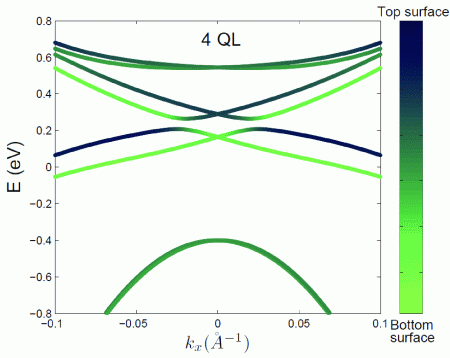Abstract
Two-dimensional (2D) effective continuous models are derived for the surface states and thin films of a three-dimensional topological insulator (3DTI). Starting from an effective model for 3DTI based on first-principles calculations (Zhang et al 2009 Nat. Phys. 5 438), we present solutions for both the surface states in a semi-infinite boundary condition and those in a thin film with finite thickness. The coupling between opposite topological surfaces and structure inversion asymmetry (SIA) gives rise to gapped Dirac hyperbolas with Rashba-like splittings in the energy spectrum. In addition, SIA leads to asymmetric distributions of wavefunctions for the surface states along the film growth direction, making some branches in the energy spectra much harder than others to probe by light. These features agree well with the recent angle-resolved photoemission spectra of Bi2Se3 films grown on SiC substrate (Zhang et al 2009 arXiv:0911.3706). More importantly, using the parameters fitted by experimental data, the result indicates that the thin film Bi2Se3 lies in the quantum spin Hall (QSH) region based on the calculation of the Chern number and Z2 invariant. In addition, strong SIA always tends to destroy the QSH state.
Export citation and abstract BibTeX RIS
GENERAL SCIENTIFIC SUMMARY Introduction and background. The topological insulator is one of the most exciting discoveries of condensed-matter physics in recent years. It originates from strong spin–orbit interaction, a relativistic effect in which electrons experience an effective magnetic field when moving in the lattice electric field. The spin–orbit coupling twists the topological nature of energy bands for some band insulators, leading to time-reversal protected metallic states around their boundaries. The boundary states, or, in the case of three-dimensional (3D) topological insulators, the surface states, have gapless Dirac dispersion as with one quarter of a graphene, and are expected to demonstrate a number of novel properties for potential applications in spintronics and quantum information.
Main results. This work presents the solution and effective model for the newly fabricated topological insulators, thin films grown from 3D topological insulator materials. Many predicted features, such as the gapped Dirac hyperbolas due to coupling between opposite topological surfaces, the structure inversion asymmetry induced by Rashba-like band splitting, and asymmetric distributions of the surface states along the film growth direction, agree well with the recent angle-resolved photoemission spectra of bismuth selenide films. More importantly, by fitting experimental data with the effective model, a crossover from 3D to 2D topological insulators is confirmed as present in the bismuth selenide.
Wider implications. This work will provide guidance for future study of the electronic transport and optical properties of topological insulator films.
 Figure. Calculated energy spectra of the surface states and several bulk bands for a four quintuple layer of bismuth selenide film in the presence of the structure inversion asymmetry. The color indicates the spatial distribution of these states in z direction.
Figure. Calculated energy spectra of the surface states and several bulk bands for a four quintuple layer of bismuth selenide film in the presence of the structure inversion asymmetry. The color indicates the spatial distribution of these states in z direction.


